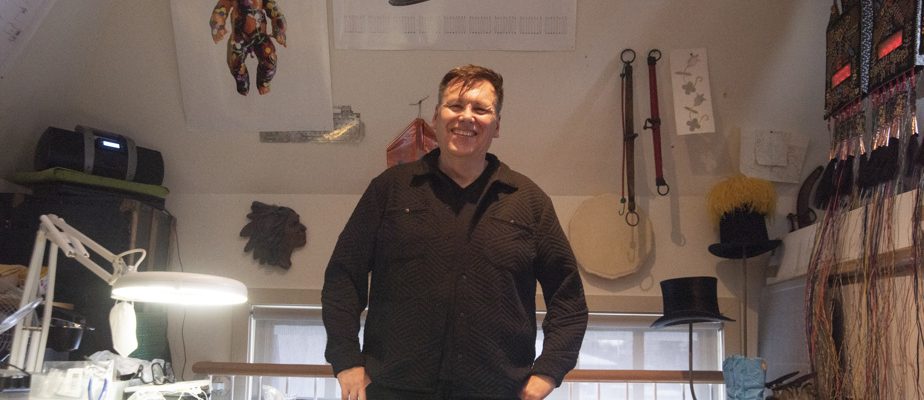Barry Ace is currently one of Canada’s best-known Aboriginal artists internationally. Not that his art is perceived as exotic in Europe or Asia, but because it is contemporary and innovative, combining Anishinaabe tradition and Western modernity. We caught up with him in his Ottawa studio.
common thread
“My father and grandfather’s dream was for me to become an electrician,” says Barry Ace. So I studied electricity. But then I stopped. One day, my 94-year-old father told me that he was proud to see that I was creating with electrical components. »

PHOTO PROVIDED BY THE NGC
Nigik Makizinan – otter moccasins2014, shoes, otter fur, velvet, electrical components, synthetic porcupine quill, white-tailed deer skin, synthetic felt, copper beads and brass bells
Anishinaabe of the M’Chigeeng Nation, Barry Ace is originally from Manitoulin Island, Ontario. He grew up and studied in Sudbury. At the age of 8, he was already creating baskets with his grandmother who taught this skill. Today, his beautifully crafted works of art are the result of a technical interbreeding, with pearls, bark, furs, copper, resistors and capacitors.
We discovered Barry Ace in 2019 during the aboriginal art expo In badakone, at the National Gallery of Canada. His work Nigik Makizinan was part of it. Shoes dragging “trace erasers” and decorated with electrical components. A creation speaking of its roots and memory. “The museum wanted to put it in a showcase. I had to tell them that if you want to decolonize, no showcase! The work is not so precious. I wanted it to be directly accessible, which Greg Hill, the curator of the exhibition, had obviously accepted. »
Radiation
Canada’s largest art auction house, Heffel, represents Barry Ace. However, this is not the vocation of Heffel, which represents only three living artists. But Barry Ace, at 64, is a valuable asset. He has built a good reputation abroad.

PHOTO PROVIDED BY HEFFEL
Mino-bimaadiziwin (The Way of Good Life)2017, regalia set
After exhibiting in New York in 2006 in an artist-run centre, he performed four performances in Paris in 2010, thanks to an invitation from the Aboriginal artist (Saulteaux) Robert Houle. Dressed in his regalia, he performed his spiritual dance at the Jardin des Tuileries, at the Louvre, on the Esplanade des Invalides and Place de la Concorde. A performance in homage to native dancers who came to Europe in 1843. “They had danced for King Louis-Philippe, George Sand was present just like Chopin and Baudelaire, and Delacroix had designed the scene,” he says.

PHOTO BONNIE DEVINE, SUPPLIED BY BARRY ACE
Performance by Barry Ace at the Jardin des Tuileries, in 2010
Barry Ace then exhibited in 2012 at the Nordamerika Native Museum in Zürich, Switzerland. The museum has many of his works. Last year he took part in the exhibition Environmental Injustice – Indigenous Alternatives, at the Geneva Museum of Ethnography. Last January, he was part of the expo Decolonial encounters at the Intermondes center in La Rochelle, France.
The workshop

PHOTO MARTIN ROY, THE LAW
Three of the four bags that will be exhibited in New York. A work on the natural elements of water, fire, wind and earth.
His studio is in a house in Ottawa. The studio is not big, but the artist is comfortable there. His recent works or those in the process of being created are scattered all over the place. He was seen working bent over a long mesh in which he threaded beads to reveal vegetation and Anishinaabe symbols. “Mesh are like digital pixels,” he says. Isn’t modern technology inspired by ancient techniques?
-

PHOTO MARTIN ROY, THE LAW
Her pearls
-

PHOTO MARTIN ROY, THE LAW
Its electrical components
1/2
Her beaded piece will be exhibited next fall at the Sundaram Tagore gallery in New York. With four shoulder bags featuring a digital display, porcupine quills and wrapped electrical wires. A creation that looks like his trinity suitea work that has been at the Art Gallery of Ontario since 2018.
Aspirations
Barry Ace can be satisfied. Testimonials of gratitude flow in. In January, the Canada Council Art Bank acquired his work Heart touching, in 2018. “It’s a great honour,” he says. Especially since this work is about the residential schools where my grandparents were forced to reside. The circuit board I put in the artwork shows that damage can always be repaired and the future can be positive. We don’t have time to look back. I want to make my contribution for generations to come. »
-

PHOTO PROVIDED BY THE ARTIST
Heart touching2018, 49 in x 15 in x 11 in
-

PHOTO MARTIN ROY, THE LAW
A piece of pearls and electrical components sewn on a copper plate, for a new shoulder bag
1/2
Barry Ace is currently exhibiting two of his works in Taiwan, at the Tainan Art Museum and the Shung Ye Museum of Formosan Aborigines. They belong to the collection of the federal Department of Crown-Indigenous Relations and Northern Affairs. He is fulfilled. He can expect a retrospective one day at the National Gallery of Canada, but he has neither impatience nor hope. Just the thirst to continue to mix the cultures of his life. “I already have a lot of exhibitions elsewhere, so everything is fine,” he says.
Photo gallery
-

PHOTO MARTIN ROY, THE LAW
A new Barry Ace basket made of bark, porcupine quills, beads and electrical components
-

PHOTO PROVIDED BY HEFFEL
erased, 2017, cowboy shoes, capacitors, resistors, diodes, glass beads, tin cones, synthetic hair and wrapped wire. Global Affairs Canada Collection.
-

PHOTO PROVIDED BY HEFFEL
Traditionala dancer’s regalia created in 2021 and recently acquired by Global Affairs Canada
-

PHOTO MARTIN ROY, THE LAW
Pottery from Barry Ace
-

PHOTO JASON JENKINS, SUPPLIED BY THE ARTIST
Barry Ace on the streets of Paris in 2010. “People were following me like it was the 1840s, touching me and asking me who I was,” he says.
-

PHOTO MARTIN ROY, THE LAW
Work in progress
1/6
